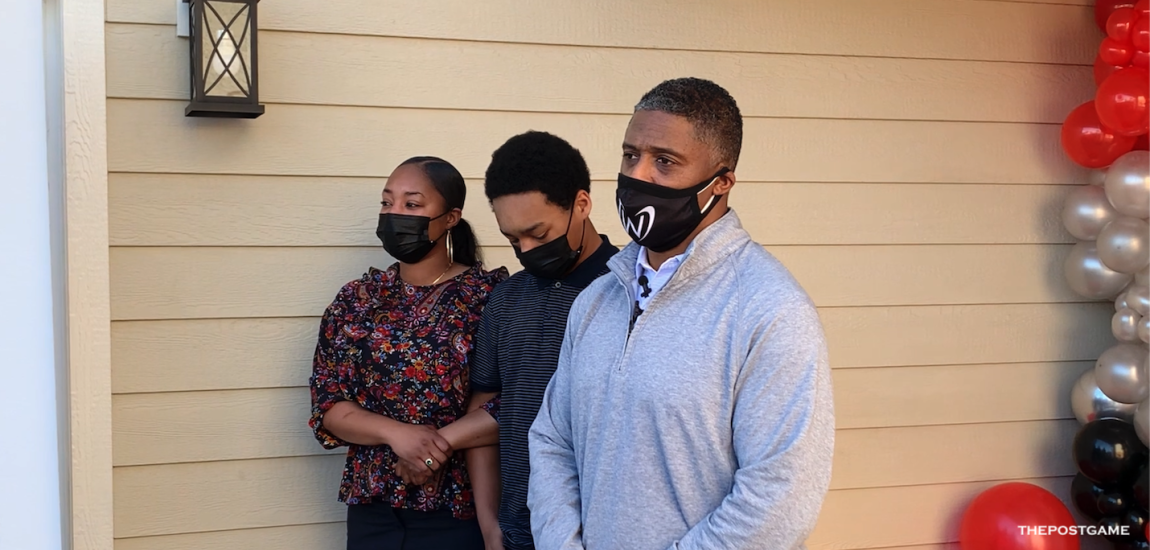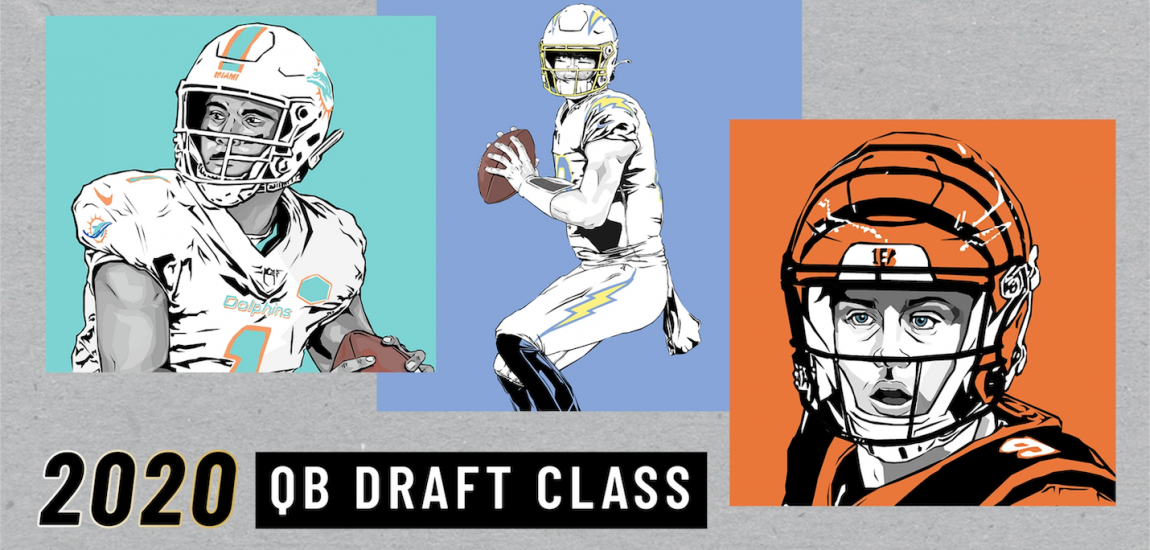On the way to attend Joe Montana's last home game with the Chiefs, David Sneid had reached the door to his garage when his wife, Kirsten, went into labor.
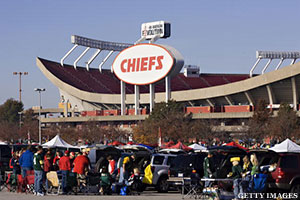
That Dec. 18, 1994, game was one of the few Sneid missed during more than 30 years as a Chiefs season-ticket holder. Through downpours, blizzards and heat waves from 1978 to 2008, he watched Todd Blackledge-led cellar dwellers and Montana-led playoff teams from his front-row, middle-of-the-end-zone seats.
But Sneid gave up his tickets four seasons ago.
Now he watches the Chiefs in his family room on his 61-inch, high-definition, flat-screen television with surround sound. He has a digital video recorder (DVR) to re-watch plays, picture-in-picture to check out other games and an iPad to look up information.
"It's more comfortable here," Sneid says. "You always have a perfect view."
Jody Males, who gave up his Steelers tickets so that he could watch on his 50-inch, HD television, says: "It's all about the way technology has advanced and brought the medium to the viewer at home. It's like you're there."
With the kind of technology available to Sneid, Males and every other fan, watching from home has never been better and is providing less incentive than ever to attend NFL games that, while entertaining, are very expensive.
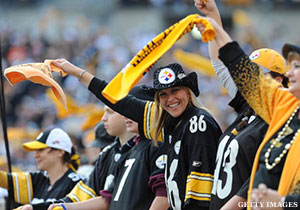
According to the Team Marketing Report's Fan Cost Index, it would have cost $427.42 for a family of four to attend an average game during the 2011 NFL season. That amount takes into account four tickets at an average price, two small beers, four small sodas, four hot dogs, parking, two programs and two adult caps.
Instead of attending all 10 home games, one could have used the money for a Samsung 51-inch, plasma HD television and three top-grain leather theater seats delivered from Best Buy. Add in the DirecTV NFL Sunday Ticket Max package for $299.95, and you would still have more than $120 to spend each week on food, beverages and team apparel.
The NFL is very aware of this discrepancy.
"The at-home experience," says Eric Grubman, NFL executive vice president-business operations, "has gotten better and cheaper over 20 years, and the in-stadium experience has gotten more expensive over 20 years, and it hasn't gotten better.
"So we need to turn that tide."
Paid attendance at NFL games remains high.
But the numbers have dipped in each successive year since 2007 when the average for a game was 67,755. That fell to 66,625 in 2008, and the slide continued: 65,043 (2009); 64,978 (2010) and 64,698 (2011).

Although the recession has played a role, those declining numbers do not account for the many season-ticket holders, who chose to stay home.
Tickets to see elite performers will never be cheap, but the NFL is pushing "a ticket price for every fan" -- flexibility to meet the demands of those in every income bracket.
"The NFL was as close to a one-size-fits-all pricing structure for a long time as you find in sports," says Marc Ganis, who has consulted on projects related to more than half of the NFL teams as president of Sportscorp Ltd. "They're now creating far more price points and of greater range."
NFL season tickets start at about mid-$20 to mid-$30 per game on the low end. The Colts' season ticket, non-club level seats range from $380 to $1,260 per season. Their $380 is at the top of south end zone and offers a view of the field and the city's skyline.
Parking adds to the overall cost, and some teams have tried to address that issue with the same kind of wide spectrum of price: More expensive for spots closest to the stadium and cheaper for those farther away. Those spots farther away, though, sometimes give fans more space to tailgate.
Aside from the fees, there is the hassle of navigating the parking lot after the game as part of the long commute home, which can become more exasperating when your team has lost.
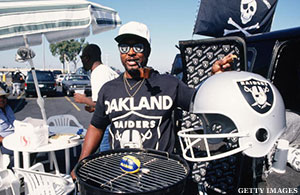
"The drive home is such a pain," Males says.
To ease traffic and facilitate their popular tailgating scene, Texans president Jamey Rootes says they employ 470 parking cashiers, tailgate ambassadors and other parking staffers -- most of whom have experience dealing with the Reliant Stadium crowd.
To encourage public transportation, a Raiders game ticket entitles the holder to a 25 percent discount on Amtrak for the date of the contest.
Teams similarly must address another irritant to fans: Costly concessions.
"The smarter teams understand that parking, concessions, tailgating opportunities are very small percentages of their gross revenues," Ganis says, "but very significantly impact the perception of the quality of the event for the fans."
The Texans have responded with flexible menu prices.
While they offer expensive, premium items like chicken fingers and french fries for about $10, they also offer -- more reasonable though not cheap -- Coca-Cola combos for $5, which gets you a hot dog and a soft drink.
Before the season, Houston's season-ticket holders also can purchase Texans Bucks, which offers a 10 percent discount on all concessions or merchandise.
League-wide, though, Ganis does not expect the price of concessions to decline.
Males, who is in three fantasy leagues, went to two to three Steelers games a year from 1991 to 2000.

But the electrical engineer now prefers monitoring NFL.com's Game Center and his fantasy team on his computer for immediate updates while watching from home instead of sitting at his former seats on the 40-yard-line, lower level.
"I couldn't have that instantaneous access," Males says. "Fantasy football's a big monster."
The NFL is trying to address those fans who not only want to receive instant data about their fantasy team but also want to exchange information about their home teams through social media.
The Ravens and Colts have developed two of the more technologically advanced stadiums.
This season the Ravens will have a Verizon Wireless 4G network to service their fans. And those attending the game can view different camera angles, the RedZone channel, stats and replays via a free Ravens mobile app. (It is available to everyone but does not have the same features outside the stadium).
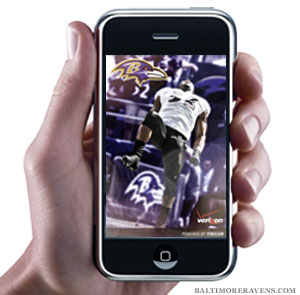
To prepare for Super Bowl XLVI, the Colts launched the second largest distributed antenna system (DAS) in North America and a Wi-Fi network.
The DAS supports more people and not does not require fans to connect but could include overage charges for those on limited plans. Wi-Fi might not have the capability to support the entire seating capacity and requires fans to connect, but it will always be free.
The NFL views Lucas Oil Stadium's connectivity as the wave of the future and hopes to roll out integrated installations -- like the Colts have -- across the league, starting in the 2013 season.
The 49ers signed a deal with Brocade Communications Systems to provide wireless technology to its new stadium, which opens in 2014.
With the stadium site in the heart of Silicon Valley, 49ers CEO Jed York has vowed to make that new stadium have the same accessibility to smartphones and tablets as a coffee shop.
But while teams have begun the expensive process to address the connectivity issues, fans often miss out on seeing action from other games or even from the home team's game.
For the 2012-13 season, the NFL -- for the first time -- will allow teams to show the same controversial, under-the-hood views that officials look at during a challenge and that fans see on their home television. Like all replays, however, it is not mandated by the league, and the team makes the programming decision.
The NFL, though, has authorized all teams to show the RedZone channel, which is immensely popular with fantasy football fans and switches to a different game when a team goes inside the 20-yard-line. But where the RedZone is displayed -- on a Jumbotron or a small television inside the concourse for example -- is up to each NFL team.
Another in-game viewing option is Dolphins owner Stephen Ross' FanVision, a wireless, handheld device.
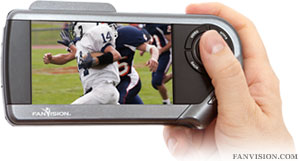
FanVision shows two other in-progress games, a RedZone channel, a fantasy football channel, two or three channels dedicated to stats, a cheerleader view, a coach's angle and up to three different views of replays.
"It (has) a multitude of other options," says Carl Peterson, the former Chiefs general manager and president who now works as a consultant for FanVision.
One can use FanVision at the stadiums of 12 teams (Bills, Dolphins, Jets, Eagles, Redskins, Bears, Broncos, Rams, Cardinals, Seahawks, Vikings and Browns).
The device costs $249 with a $5 activation fee per game, but consumers can rent it instead for individual games. FanVision also is developing an app with similar features.
Since viewing games from home has become so appealing, teams must think of creative ways to attract fans.
Cowboys Stadium has become an attraction in itself, which is impossible to replicate from your couch.
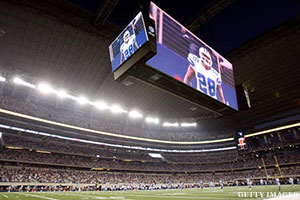
JerryWorld has four video screens. The two facing the sideline measure 160 feet by 72 feet, and the two facing the end zone are 53 by 30.
Those screens create such a spectacle that Cowboys fans told a reporter they spent much of their time at a game watching the action on the video board instead of the field.
Jimmy Buffett, a business partner of Ross, performed an outdoor concert for thousands of tailgaters before a Dolphins game.
The Raiders went outside the box to create entertainment. A Lifetime show called "Coming Home" filmed an episode on the field at halftime last year. During the show, a son kicked a field goal in honor of his father, serving in Afghanistan. The family was then unexpectedly reunited with their father, who unbeknownst to them was the holder while wearing a full uniform with a helmet and darkened visor.
After his identity was revealed, the crowd erupted, chanting, "USA, USA!"
The Raiders also have a popular tailgating area called Raiderville on nearly an acre of land where fans can watch the early games on flat-screen televisions for free. Raiderville includes food providers, family zones, sponsor booths and a chance to meet and receive autographs from "Raiders Legends" like Jim Otto, Fred Biletnikoff and Cliff Branch. (About half a dozen "Legends" appear before every game and also interact with fans in the stadium clubs, according to Raiders CEO Amy Trask).
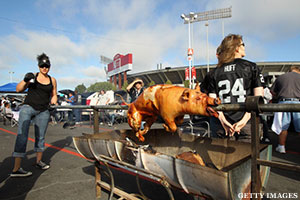
Other teams, including the Ravens and Bills, have set up a similar pregame area, which also features their pregame radio show.
Teams continue to brainstorm ideas to not only heighten the pregame experience, but also encourage fans to purchase season tickets.
The Raiders took a philanthropic approach and planned to donate 10 percent of the gross for all season tickets purchased between May 1 and June 30 to the Oakland Unified School District.
Their AFC West brethren, the Chiefs and Chargers, also creatively reward season-ticket holders.
Kansas City is giving new and existing season-ticket holders a free, authentic and personalized Chiefs Nike jersey during 2012. San Diego's giveaway is a mini-helmet, and all season-ticket holders are entered in a sweepstakes to win prizes, including a trip to the Super Bowl and road trips to Chargers games.
But if more fans view from home instead of going to the stadium, is it really an issue for the NFL?
After all, the most-watched sport in the United States receives most of its money through lucrative television contracts.
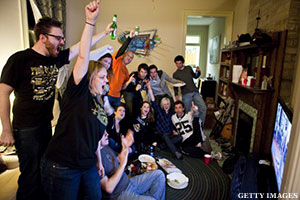
"What we want is for more fans to watch in both places," Grubman says. "We haven't exhausted the number of people who can have a great experience watching an NFL game."
The NFL renewed its television contracts during December 2011, and the extensions will run from the end of the 2013 season to the end of the 2022 season and bring in about $3 billion a year.
With that kind of money pouring in from television, NFL executives often field the question whether television is more of a priority for them than the in-stadium experience.
"Our job is to make sure that each of the those two experiences is as good as it could possibly be," Grubman says. "We've got a lot of work to do in the stadium, and that's why we're spending time on it."
Commissioner Roger Goodell even emphasized that enhancement during the May owners' meetings.

"We have made the point repeatedly that the experience at home is outstanding," Goodell told USA Today Sports Media Group. "And we have to compete with that in some fashion by making sure that we create the same kind of environment in our stadiums…
"We want [fans] to have access to the same information, have access to our RedZone, have access to highlights, be able to engage in social media, including fantasy football. When you come to our stadium, we want to make it a great experience."
Grubman reasserted that taking care of the fans at the stadium is a priority, despite the fact that ticket, concession and parking revenue represent a small piece of the pie.
"What we're going to do is produce great content and then we're going to figure out the best possible ways to distribute that content," he says. "If we get that right, the money will take care of itself."
Attending an NFL game remains a unique experience.

"Going into an NFL game is not simply the act of watching the game," Ganis says. "It's watching it with a group of others. It's the energy from the crowd. It's a feeling like you have an even greater connection to the team and the players."
That special connection is fostered when the crowd makes so much noise that the opposing team commits a penalty because it cannot hear the snap.
During the 2010 raucous season opener in monsoon-like conditions at Arrowhead Stadium, quarterback Philip Rivers became so frustrated after a delay-of-game penalty that he kicked a football in disgust.
"I miss the ambience," Sneid says of Arrowhead. "It's always more exciting if you're there."
But is it worth the cost when you already have a comfortable couch, a flat-screen television and other gadgetry at home?





